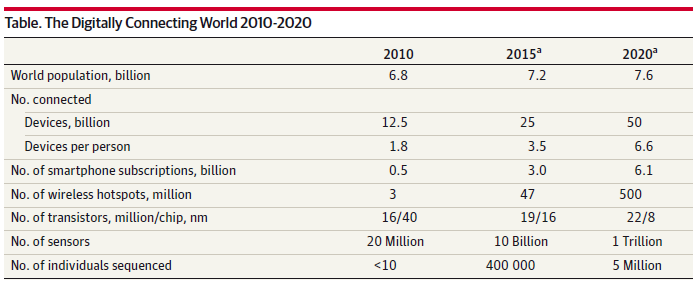The Future of Medicine and the Internet of Things
As previously noted on this blog, investments in digital health ventures doubled in 2014. Institutions, analysts and MDs envision the opportunity to reduce the colossal inefficiency of current medical practice by exploiting the Internet of Things.
According to a recent JAMA article, the number of mobile devices connected via the internet is doubling every five years, and there will be nearly seven connected devices per individual by 2020.
Source: Digital Medical Tools and Sensors from JAMA.
The development most directly impacting today’s patient is sensors in smartphones and wearable devices. Such technology quantify physiologic metrics ranging from an individual’s number of steps taken to his or her vital signs.
Smartphones have already achieved what pedometers have not: Wide adoption by the general population. Nearly two out of three U.S. adults own a smartphone and over one in four Americans have used sensors to track activity.
Counting steps has been a successful tool used to improve clinical outcomes. According to a recent JAMA research letter, smartphone applications were statistically accurate for step counts. The authors exert, “increased physical activity facilitated by these devices could lead to clinical benefits not realized by low adoption of pedometers.”
Smartphone cameras can now diagnose skin lesions with accuracy equivalent to or exceeding that of physicians. We can expect similar applications for blood pressure and glucose levels within five years.
As digital medicine moves rapidly, key dynamics to monitor include congressional approval and privacy issues. The medical community, regulators and consumers will decide how these innovations are used. The technology itself, however, is not slowing down for anyone.



Goal: 10,000 steps.
Average: 6,000 steps.
Today: 12,000 steps.
Impressive, what do you use to track your steps?
“increased physical activity facilitated by these devices could lead to clinical benefits not realized by low adoption of pedometers.”
very true!
“The medical community, regulators and consumers will decide how these innovations are used”
So not true. Consumers have no say anymore. The Internet of Things is being pushed and will be forced upon us.
JAMA should look into the impact of all these man made frequencies bombarding us daily and the impact on our bodies. Will it make us healthier or sicker?
Medicine will turn into the nightmare we now experience when trying to contact customer service for companies. It will take the “service” out of it.
Thank you. Interesting perspective. Generally speaking, you are not alone in your concerns.